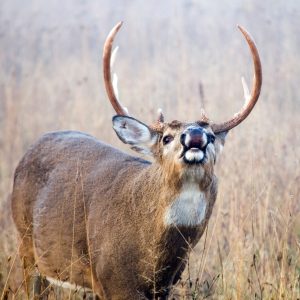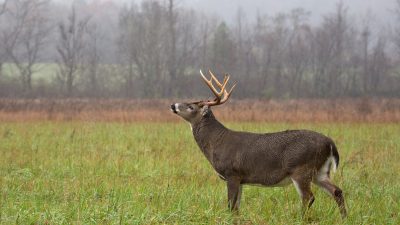I was eager to try out a new potential hotspot and when my weather app showed the right wind direction I packed up my gear and paddled the half mile of stream to where I’d hung my stand two weeks earlier. I was so eager to get up and in the stand I didn’t pay much attention to the wind until I was seated and had hung my bow. Then it hit me, right in the back of my neck.
At first I thought maybe it was just an errant gust but soon realized the wind was wrong, and remaining would only burn my stand. While the weather app properly predicted the prevailing wind direction, I had failed to take into account the effect of topography and structure. Clearly there was more I needed to learn about this spot before it could be hunted effectively.
Whitetail’s Sense of Smell
Of all the whitetail’s senses we need to overcome in order to outwit them, smell is the most important. Scent suppression is important, but even the most diligent and comprehensive scent control system is imperfect, which makes understanding and exploiting air currents even more important. And the more you learn about “the way of the wind,” the more you realize just how complicated it can get. For starters, there are multiple factors involved that seldom if ever work independent of one another. Second, each can be as fickle as, and largely dependent on the weather. Still, the more we know about how and why air moves, the more advantage we gain.

Bob Humphrey
Thermal Effect
Most hunters have probably noticed that it often feels coldest just before the sun comes up. You might rationalize that it’s because you got on stand early and after sitting still for some time your body is cooling down. But, it’s also quite possible that it is in fact colder, and here’s why.
As the sun rises it hits the land, warming the ground and the air at ground level. Warm air rises and is replaced by colder air falling from the atmosphere. Because the angle of the sun rising in the east grows increasingly steeper, this warming process moves in a west to east direction. This, in turn, results in an east-west movement of air, even on the calmest of days, and on flat ground.
Thermal Effect in Altitudes
This thermal effect is magnified in rough terrain. Sunlight hits the mountain and ridgetops first. The warm air rises, pulling cold air behind it resulting in a general uphill thermal flow. In the afternoon as the tops cool, thermals flow downhill. That could be at least part of the reason deer tend to move uphill in the morning and downhill in the evening. In so doing, they can look for danger ahead and still smell it from behind. If it were all just that simple we hunters would likely be a lot more successful, but there are other factors at work.
Thermal Effect in Latitudes
One factor is general weather patterns. Weather in most of the middle latitudes (35-50 degrees North) moves from west to east, with a more southerly flow in summer and northerly flow in winter; so prevailing winds are from the southwest during summer, then gradually shift toward the northwest in winter as the earth’s axis tilts the northern hemisphere away from the sun. At least, that’s the general pattern.

Bruce MacQueen
Changes in barometric pressure and thus weather, also cause changes in wind direction and intensity. In general, winds blow clockwise and outward from the center of a high pressure area and counter-clockwise and inward toward the center of a low. High pressure tends to host fair weather and (westerly) winds while low pressure often brings foul weather and atypical wind direction – usually an easterly flow. Meanwhile, the interface between areas of high and low pressure is where things really get interesting. The environment constantly works toward equilibrium and the greater the pressure differential between air masses, the stronger the winds.
All this is worth knowing, especially if you’re not consistently monitoring your barometer. A shift to easterly winds usually accompanies a falling barometer and impending bad weather. Deer and other animals will sense it long before you do and will be out feeding in advance. Similarly, after an extended period of bad weather, you’ll want to be out in the woods when the wind comes back around to westerly.
If all the above is not complicated enough, even fair winds don’t necessarily flow in a straight line. The “Coriolis effect,” caused by earth’s rotation, causes winds in the northern hemisphere to veer or change direction in a clockwise direction… most of the time. Approaching storms can cause backing winds, which change in a counter-clockwise direction, usually from southwest to south, then southeast. It’s helpful, but not crucial you know that.
If you live near the coast, or a large waterbody, you might also want to know how those influence wind patterns. During the day, land warms faster than water, this creates a general onshore wind pattern also known as a sea breeze. At day’s end, the land cools having the reverse effect.
Here’s another tip a lot of folks probably don’t know. If you hunt anywhere within 100 miles of the coast you’ve probably experienced a point during the day when the wind just seemed to die for an hour or so, then pick up again, and often change direction. It could be any time of day with seemingly no connection to weather. Next time that happens, look at the local tide chart. The wind often dies during slack tide and the effect can be observed well inland.
Wind Movement On The Landscape
Two more very important factors, as noted in the opening passage, are topography and structure. Just like water, wind travels more or less straight until it encounters an obstacle and is deflected. In fact, one of the best ways to better understand local air flow is to look at a topographical map (or even better, a 3-D image) of the land you hunt and try to envision how water would flow over it if all the land was flooded. Obviously, it depends on prevailing wind direction and velocity so you can never be entirely accurate in your prediction, but you can come close.
The Best Wind for Deer Hunting

Bob Humphrey
You might think that having the wind directly in your face is the best possible circumstance, and it might be, at least as far as the probability of being detected. But deer rarely travel exactly where we want them to, especially directly upwind. That’s why my preferred situation is when the wind is almost wrong…almost.
Deer are very aware of, and often use the wind direction to their advantage in trying to detect danger, food, or a potential mate. They’ll use the optimal route to do so and if you can find a way to exploit it, your odds get better. Try to find a situation where deer can get close, but some obstacle prevents them from getting directly downwind of you.
The Worst Wind for Deer Hunting
In law, an attractive nuisance is a dangerous condition that may particularly attract children and pose a risk to their safety. In deer hunting, it’s something that may particularly attract hunters, and poses a risk to their sanity and hunting success. Narrow bottoms, especially along streams or river channels are just such an attractive nuisance. They’re awfully tempting places to hunt because they tend to funnel and concentrate deer movement, but there are good reasons why deer are there. These bottoms tend to collect and hold air from adjacent uplands on both sides. If you’re set up on either side, your scent is going down into the very bottom where deer travel most. Then, regardless of prevailing wind direction, localized flow tends to travel up and down along the long axis of these corridors and tends to swirl more, leaving almost no place with favorable air flow for the hunter.
Wind Speed and Deer Movement
Speed, too, is a factor. While there’s not a ton of empirical data to back it up, 50 years of practical experience has shown me that white-tailed deer move less in high winds. It only makes sense. The woods are full of noise and motion, both of which represent potential danger. Deer will usually sit tight, but that offers an opportunity for still-hunting and stalking. Even better, you won’t have much trouble monitoring wind direction.
Now that you have a little better understanding of how wind and thermal currents work, let’s look at a few practical applications.
Food Plot Stand Placement

Bob Humphrey
Let’s say you want to set a bow stand along the edge of a food plot. You have at least two edges to choose from, maybe more depending on shape and configuration. Prevailing winds are from the west. That eliminates the east side where wind will be blowing back into the woods and any deer approaching from behind will nail you. The western side is often where deer first enter a food plot because it gets the first shade and cools down earlier. However, any deer that walk in front of you will nail you. The northern or southern edges might be a better option – south in the early fall and north in late fall – as this gives you the largest radius of favorable winds in and around the plot.
If you’re goal is a mature buck, you may want to re-think things. Those bucks don’t get old and big by being stupid. During peak rut they might wander out in the open but far more often they’re going to be back in the woods on the downwind side where they can scent-check the field for hot does without exposing themselves to danger. This is when you want to be 75-100 yards into the woods on the downwind side.
Hunting Hills and Ridges
Areas of topography present their own challenges, and opportunities. Deer prefer to travel up and down draws but as noted above, being down in the draw is less than ideal. It’s better to be at or near the top of the downwind side, but if that doesn’t provide a good ambush opportunity, you may be able to get away with being on the upwind side as the wind will blow your scent above the deer.
It’s easier to imagine how hard topographical features like hills and ridges might deflect wind but you also need to consider that even something softer like a stand of trees can deflect and disperse wind. Sometimes you can’t predict it, which is why it’s a good idea to carry some type of wind indicator like powder, tufts of fabric or even milkweed down. You might be quite surprised by what you see.
Conclusion
Every situation is different but hopefully this will inspire you to apply your new found knowledge to your own “back 40.” You can’t just look at your weather app and assume it’s entirely accurate in predicting wind direction for a specific stand. But you can take notes on which stands are best for which winds, and some apps even allow you to enter optimum conditions for each. And this doesn’t apply just to whitetails; it includes any and all keen-nosed big game and predators.
Join our weekly newsletter or subscribe to GameKeepers Magazine.
Your source for information, equipment, know-how, deals and discounts to help you get the most from every hard-earned moment in the field.







